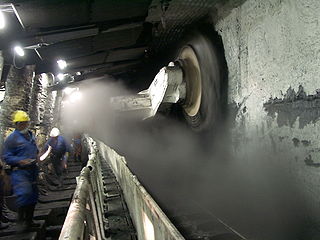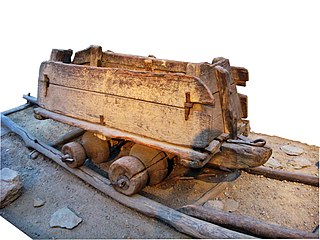
Mining is the extraction of valuable minerals or other geological materials from the Earth, usually from an ore body, lode, vein, seam, reef or placer deposit. These deposits form a mineralized commodity that is of economic interest to the miner.

Underground hard rock mining refers to various underground mining techniques used to excavate hard minerals, usually those containing metals such as ore containing gold, silver, iron, copper, zinc, nickel, tin and lead, but also involves using the same techniques for excavating ores of gems such as diamonds or rubies. Soft rock mining refers to excavation of softer minerals such as salt, coal, or oil sands.
Coal mining is the process of extracting coal from the ground. Coal is valued for its energy content and since the 1880s, has been widely used to generate electricity. Steel and cement industries use coal as a fuel for extraction of iron from iron ore and for cement production. In the United Kingdom and South Africa, a coal mine and its structures are a colliery, a coal mine is a 'pit', and the above-ground structures are a 'pit head'. In Australia, "colliery" generally refers to an underground coal mine.

Placer mining is the mining of stream bed (alluvial) deposits for minerals. This may be done by open-pit or by various surface excavating equipment or tunneling equipment.

Longwall mining is a form of underground coal mining where a long wall of coal is mined in a single slice. The longwall panel is typically 3–4 km (1.9–2.5 mi) long and 250–400 m (820–1,310 ft) wide.

Surface mining, including strip mining, open-pit mining and mountaintop removal mining, is a broad category of mining in which soil and rock overlying the mineral deposit are removed, in contrast to underground mining, in which the overlying rock is left in place, and the mineral is removed through shafts or tunnels.
Drift mining is either the mining of an ore deposit by underground methods, or the working of coal seams accessed by adits driven into the surface outcrop of the coal bed. A drift mine is an underground mine in which the entry or access is above water level and generally on the slope of a hill, driven horizontally into the ore seam. Random House dictionary says the origin of the term "drift mine" is an Americanism, circa 1885–1890.

A cave-in is a collapse of a geologic formation, mine or structure which may occur during mining or tunneling. Geologic structures prone to spontaneous cave-ins include alvar, tsingy and other limestone formations, but can also include lava tubes and a variety of other subsurface rock formations. Glacier caves and other ice formations are very prone to collapse from exposure to warm temperatures or running water.
Room and pillar, is a mining system in which the mined material is extracted across a horizontal plane, creating horizontal arrays of rooms and pillars. To do this, "rooms" of ore are dug out while "pillars" of untouched material are left to support the roof overburden. Calculating the size, shape, and position of pillars is a complicated procedure, and is an area of active research. The technique is usually used for relatively flat-lying deposits, such as those that follow a particular stratum. Room and pillar mining can be advantageous because it reduces the risk of surface subsidence compared to other underground mining techniques. It is also advantageous because it can be mechanized, and is relatively simple. However, because significant portions of ore may have to be left behind, recovery and profits can be low. Room and pillar mining was one of the earliest methods used, although with significantly more man-power.
The Crandall Canyon Mine, formerly Genwal Mine, was an underground bituminous coal mine in northwestern Emery County, Utah.

Retreat mining is the removal of pillars in the underground mining technique known as room and pillar mining.

A minecart or mine cart is a type of rolling stock found on a mine railway, used for moving ore and materials procured in the process of traditional mining. Minecarts are seldom used in modern operations, having largely been superseded in underground operations by more efficient belt conveyor systems that allow machines such as longwall shearers and continuous miners to operate at their full capacity, and above ground by large dumpers.

The following outline is provided as an overview of and topical guide to mining:

SAG/SDAG Wismut was a uranium mining company in East Germany during the time of the cold war. It produced a total of 230,400 tonnes of uranium between 1947 and 1990 and made East Germany the fourth largest producer of uranium ore in the world at the time. It was the largest single producer of uranium ore in the entire sphere of control of the USSR. In 1991 after German reunification it was transformed into the Wismut GmbH company, owned by the Federal Republic of Germany, which is now responsible for the restoration and environmental cleanup of the former mining and milling areas. The head office of SDAG Wismut / Wismut GmbH is in Chemnitz-Siegmar.

Stoping is the process of extracting the desired ore or other mineral from an underground mine, leaving behind an open space known as a stope. Stoping is used when the country rock is sufficiently strong not to collapse into the stope, although in most cases artificial support is also provided.
The Meco-Moore cutter loader was an early twentieth-century British mining machine. It was invented by Mr M. Moore, and developed by the Mining Engineering Company (MECO) of Worcester. It was a heavy machine and was first used in a coal mine in Lancashire, England 1934. The design was such that it worked along the coal seam The machine's cutter bars, the "jibs" as they were called, were designed to both shear and undercut the coal seam. The cut coal was cut onto the connected conveyor belt system which took it towards the mine's entrance. It was, or was among, the first such machines to do both cutting and loading at the same time. The machine increased both productivity and safety.

The Anderton Shearer Loader is a coal cutting machine which was used in the UK coal industry after 1953. The Anderton Power Loader with its cutting drum up to five feet in diameter was patented in 1953. It was successfully used throughout the British coalfields and by 1966 cut half the coal produced and by 1977 it produced 80% of the coal mined in Britain.

Joy Global Inc. was a company that manufactured and serviced heavy equipment used in the extraction and haulage of coal and minerals in both underground and surface mining. The company had manufacturing facilities in Alabama, Pennsylvania, Texas, Wisconsin, Australia, Canada, China, France, South Africa and the United Kingdom. In 2017, Joy Global was acquired by Komatsu Limited and was renamed Komatsu Mining Corp.
Optimisation of cutting cycles in conventional underground coal sections to improve productivity serves as an area of study that deals with the utilisation of the machines in conventional underground coal sections. Utilisation of machines focuses on reducing the time that machines spend idle and increasing the amount of time during shifts that machines are actively contributing to production. This can be addressed through effective planning of the cutting cycle parameters or by adjusting the design of machines to modify the cutting cycles
This is a partial glossary of coal mining terminology commonly used in the coalfields of the United Kingdom. Some words were in use throughout the coalfields, some are historic and some are local to the different British coalfields.













